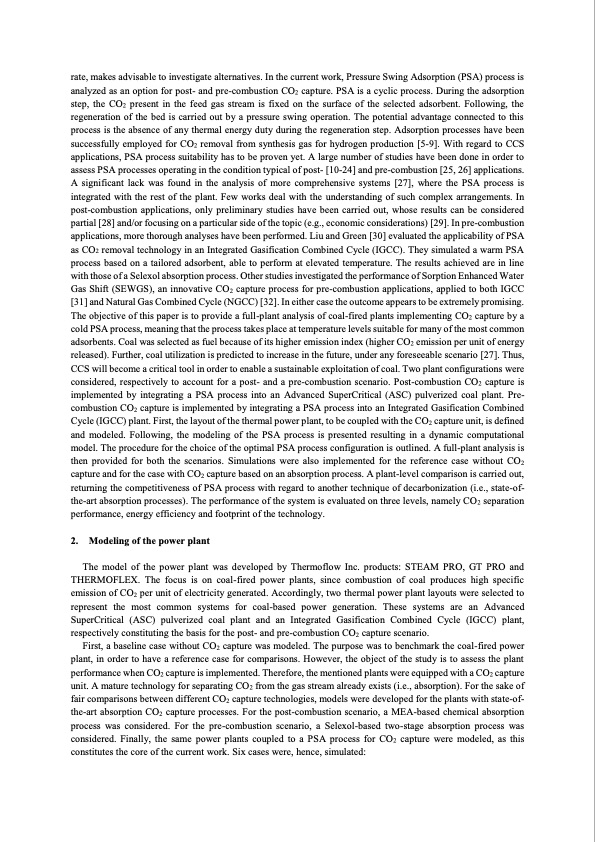
PDF Publication Title:
Text from PDF Page: 002
rate, makes advisable to investigate alternatives. In the current work, Pressure Swing Adsorption (PSA) process is analyzed as an option for post- and pre-combustion CO2 capture. PSA is a cyclic process. During the adsorption step, the CO2 present in the feed gas stream is fixed on the surface of the selected adsorbent. Following, the regeneration of the bed is carried out by a pressure swing operation. The potential advantage connected to this process is the absence of any thermal energy duty during the regeneration step. Adsorption processes have been successfully employed for CO2 removal from synthesis gas for hydrogen production [5-9]. With regard to CCS applications, PSA process suitability has to be proven yet. A large number of studies have been done in order to assess PSA processes operating in the condition typical of post- [10-24] and pre-combustion [25, 26] applications. A significant lack was found in the analysis of more comprehensive systems [27], where the PSA process is integrated with the rest of the plant. Few works deal with the understanding of such complex arrangements. In post-combustion applications, only preliminary studies have been carried out, whose results can be considered partial [28] and/or focusing on a particular side of the topic (e.g., economic considerations) [29]. In pre-combustion applications, more thorough analyses have been performed. Liu and Green [30] evaluated the applicability of PSA as CO2 removal technology in an Integrated Gasification Combined Cycle (IGCC). They simulated a warm PSA process based on a tailored adsorbent, able to perform at elevated temperature. The results achieved are in line with those of a Selexol absorption process. Other studies investigated the performance of Sorption Enhanced Water Gas Shift (SEWGS), an innovative CO2 capture process for pre-combustion applications, applied to both IGCC [31] and Natural Gas Combined Cycle (NGCC) [32]. In either case the outcome appears to be extremely promising. The objective of this paper is to provide a full-plant analysis of coal-fired plants implementing CO2 capture by a cold PSA process, meaning that the process takes place at temperature levels suitable for many of the most common adsorbents. Coal was selected as fuel because of its higher emission index (higher CO2 emission per unit of energy released). Further, coal utilization is predicted to increase in the future, under any foreseeable scenario [27]. Thus, CCS will become a critical tool in order to enable a sustainable exploitation of coal. Two plant configurations were considered, respectively to account for a post- and a pre-combustion scenario. Post-combustion CO2 capture is implemented by integrating a PSA process into an Advanced SuperCritical (ASC) pulverized coal plant. Pre- combustion CO2 capture is implemented by integrating a PSA process into an Integrated Gasification Combined Cycle (IGCC) plant. First, the layout of the thermal power plant, to be coupled with the CO2 capture unit, is defined and modeled. Following, the modeling of the PSA process is presented resulting in a dynamic computational model. The procedure for the choice of the optimal PSA process configuration is outlined. A full-plant analysis is then provided for both the scenarios. Simulations were also implemented for the reference case without CO2 capture and for the case with CO2 capture based on an absorption process. A plant-level comparison is carried out, returning the competitiveness of PSA process with regard to another technique of decarbonization (i.e., state-of- the-art absorption processes). The performance of the system is evaluated on three levels, namely CO2 separation performance, energy efficiency and footprint of the technology. 2. Modeling of the power plant The model of the power plant was developed by Thermoflow Inc. products: STEAM PRO, GT PRO and THERMOFLEX. The focus is on coal-fired power plants, since combustion of coal produces high specific emission of CO2 per unit of electricity generated. Accordingly, two thermal power plant layouts were selected to represent the most common systems for coal-based power generation. These systems are an Advanced SuperCritical (ASC) pulverized coal plant and an Integrated Gasification Combined Cycle (IGCC) plant, respectively constituting the basis for the post- and pre-combustion CO2 capture scenario. First, a baseline case without CO2 capture was modeled. The purpose was to benchmark the coal-fired power plant, in order to have a reference case for comparisons. However, the object of the study is to assess the plant performance when CO2 capture is implemented. Therefore, the mentioned plants were equipped with a CO2 capture unit. A mature technology for separating CO2 from the gas stream already exists (i.e., absorption). For the sake of fair comparisons between different CO2 capture technologies, models were developed for the plants with state-of- the-art absorption CO2 capture processes. For the post-combustion scenario, a MEA-based chemical absorption process was considered. For the pre-combustion scenario, a Selexol-based two-stage absorption process was considered. Finally, the same power plants coupled to a PSA process for CO2 capture were modeled, as this constitutes the core of the current work. Six cases were, hence, simulated:PDF Image | Evaluating Pressure Swing Adsorption as a CO2 separation technique in coal-fired

PDF Search Title:
Evaluating Pressure Swing Adsorption as a CO2 separation technique in coal-firedOriginal File Name Searched:
PSA-coal-fired-plants.pdfDIY PDF Search: Google It | Yahoo | Bing
CO2 Organic Rankine Cycle Experimenter Platform The supercritical CO2 phase change system is both a heat pump and organic rankine cycle which can be used for those purposes and as a supercritical extractor for advanced subcritical and supercritical extraction technology. Uses include producing nanoparticles, precious metal CO2 extraction, lithium battery recycling, and other applications... More Info
Heat Pumps CO2 ORC Heat Pump System Platform More Info
| CONTACT TEL: 608-238-6001 Email: greg@infinityturbine.com | RSS | AMP |